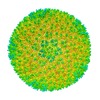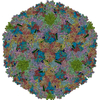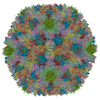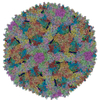+ Open data
Open data
- Basic information
Basic information
| Entry | Database: EMDB / ID: EMD-4633 | |||||||||||||||
|---|---|---|---|---|---|---|---|---|---|---|---|---|---|---|---|---|
| Title | Cryo-EM structure of SH1 full particle. | |||||||||||||||
 Map data Map data | Block-based reconstruction of SH1 capsid, filtered at 3.8 Angstrom and sharpened with a B-factor=-90 | |||||||||||||||
 Sample Sample |
| |||||||||||||||
 Keywords Keywords | euryarcheal virus / SH1 / VIRUS | |||||||||||||||
| Function / homology | ORF 31 / ORF 25 / ORF 24 Function and homology information Function and homology information | |||||||||||||||
| Biological species |  Haloarcula hispanica virus SH1 Haloarcula hispanica virus SH1 | |||||||||||||||
| Method | single particle reconstruction / cryo EM / Resolution: 3.8 Å | |||||||||||||||
 Authors Authors | De Colibus L / Roine E / Walter TS / Ilca SL | |||||||||||||||
| Funding support |  United Kingdom, United Kingdom,  Finland, 4 items Finland, 4 items
| |||||||||||||||
 Citation Citation |  Journal: Nat Commun / Year: 2019 Journal: Nat Commun / Year: 2019Title: Assembly of complex viruses exemplified by a halophilic euryarchaeal virus. Authors: Luigi De Colibus / Elina Roine / Thomas S Walter / Serban L Ilca / Xiangxi Wang / Nan Wang / Alan M Roseman / Dennis Bamford / Juha T Huiskonen / David I Stuart /    Abstract: Many of the largest known viruses belong to the PRD1-adeno structural lineage characterised by conserved pseudo-hexameric capsomers composed of three copies of a single major capsid protein (MCP). ...Many of the largest known viruses belong to the PRD1-adeno structural lineage characterised by conserved pseudo-hexameric capsomers composed of three copies of a single major capsid protein (MCP). Here, by high-resolution cryo-EM analysis, we show that a class of archaeal viruses possess hetero-hexameric MCPs which mimic the PRD1-adeno lineage trimer. These hetero-hexamers are built from heterodimers and utilise a jigsaw-puzzle system of pegs and holes, and underlying minor capsid proteins, to assemble the capsid laterally from the 5-fold vertices. At these vertices proteins engage inwards with the internal membrane vesicle whilst 2-fold symmetric horn-like structures protrude outwards. The horns are assembled from repeated globular domains attached to a central spine, presumably facilitating multimeric attachment to the cell receptor. Such viruses may represent precursors of the main PRD1-adeno lineage, similarly engaging cell-receptors via 5-fold spikes and using minor proteins to define particle size. | |||||||||||||||
| History |
|
- Structure visualization
Structure visualization
| Movie |
 Movie viewer Movie viewer |
|---|---|
| Structure viewer | EM map:  SurfView SurfView Molmil Molmil Jmol/JSmol Jmol/JSmol |
| Supplemental images |
- Downloads & links
Downloads & links
-EMDB archive
| Map data |  emd_4633.map.gz emd_4633.map.gz | 530.2 MB |  EMDB map data format EMDB map data format | |
|---|---|---|---|---|
| Header (meta data) |  emd-4633-v30.xml emd-4633-v30.xml emd-4633.xml emd-4633.xml | 29.7 KB 29.7 KB | Display Display |  EMDB header EMDB header |
| Images |  emd_4633.png emd_4633.png | 242.8 KB | ||
| Filedesc metadata |  emd-4633.cif.gz emd-4633.cif.gz | 6.9 KB | ||
| Others |  emd_4633_additional_1.map.gz emd_4633_additional_1.map.gz emd_4633_additional_2.map.gz emd_4633_additional_2.map.gz emd_4633_half_map_1.map.gz emd_4633_half_map_1.map.gz emd_4633_half_map_2.map.gz emd_4633_half_map_2.map.gz | 8.5 MB 7.9 MB 530.5 MB 530.5 MB | ||
| Archive directory |  http://ftp.pdbj.org/pub/emdb/structures/EMD-4633 http://ftp.pdbj.org/pub/emdb/structures/EMD-4633 ftp://ftp.pdbj.org/pub/emdb/structures/EMD-4633 ftp://ftp.pdbj.org/pub/emdb/structures/EMD-4633 | HTTPS FTP |
-Validation report
| Summary document |  emd_4633_validation.pdf.gz emd_4633_validation.pdf.gz | 422.5 KB | Display |  EMDB validaton report EMDB validaton report |
|---|---|---|---|---|
| Full document |  emd_4633_full_validation.pdf.gz emd_4633_full_validation.pdf.gz | 421.7 KB | Display | |
| Data in XML |  emd_4633_validation.xml.gz emd_4633_validation.xml.gz | 22 KB | Display | |
| Arichive directory |  https://ftp.pdbj.org/pub/emdb/validation_reports/EMD-4633 https://ftp.pdbj.org/pub/emdb/validation_reports/EMD-4633 ftp://ftp.pdbj.org/pub/emdb/validation_reports/EMD-4633 ftp://ftp.pdbj.org/pub/emdb/validation_reports/EMD-4633 | HTTPS FTP |
-Related structure data
| Related structure data |  6qt9MC  4634C  4656C M: atomic model generated by this map C: citing same article ( |
|---|---|
| Similar structure data |
- Links
Links
| EMDB pages |  EMDB (EBI/PDBe) / EMDB (EBI/PDBe) /  EMDataResource EMDataResource |
|---|
- Map
Map
| File |  Download / File: emd_4633.map.gz / Format: CCP4 / Size: 1.9 GB / Type: IMAGE STORED AS FLOATING POINT NUMBER (4 BYTES) Download / File: emd_4633.map.gz / Format: CCP4 / Size: 1.9 GB / Type: IMAGE STORED AS FLOATING POINT NUMBER (4 BYTES) | ||||||||||||||||||||||||||||||||||||||||||||||||||||||||||||||||||||
|---|---|---|---|---|---|---|---|---|---|---|---|---|---|---|---|---|---|---|---|---|---|---|---|---|---|---|---|---|---|---|---|---|---|---|---|---|---|---|---|---|---|---|---|---|---|---|---|---|---|---|---|---|---|---|---|---|---|---|---|---|---|---|---|---|---|---|---|---|---|
| Annotation | Block-based reconstruction of SH1 capsid, filtered at 3.8 Angstrom and sharpened with a B-factor=-90 | ||||||||||||||||||||||||||||||||||||||||||||||||||||||||||||||||||||
| Projections & slices | Image control
Images are generated by Spider. | ||||||||||||||||||||||||||||||||||||||||||||||||||||||||||||||||||||
| Voxel size | X=Y=Z: 1.35 Å | ||||||||||||||||||||||||||||||||||||||||||||||||||||||||||||||||||||
| Density |
| ||||||||||||||||||||||||||||||||||||||||||||||||||||||||||||||||||||
| Symmetry | Space group: 1 | ||||||||||||||||||||||||||||||||||||||||||||||||||||||||||||||||||||
| Details | EMDB XML:
CCP4 map header:
| ||||||||||||||||||||||||||||||||||||||||||||||||||||||||||||||||||||
-Supplemental data
-Additional map: Sharpened and non-icosahedrally averaged map of VP7 protein
| File | emd_4633_additional_1.map | ||||||||||||
|---|---|---|---|---|---|---|---|---|---|---|---|---|---|
| Annotation | Sharpened and non-icosahedrally averaged map of VP7 protein | ||||||||||||
| Projections & Slices |
| ||||||||||||
| Density Histograms |
-Additional map: Sharpened and non-icosahedrally averaged map of VP4 protein
| File | emd_4633_additional_2.map | ||||||||||||
|---|---|---|---|---|---|---|---|---|---|---|---|---|---|
| Annotation | Sharpened and non-icosahedrally averaged map of VP4 protein | ||||||||||||
| Projections & Slices |
| ||||||||||||
| Density Histograms |
-Half map: Block-based reconstruction of SH1 capsid, halfmap 2
| File | emd_4633_half_map_1.map | ||||||||||||
|---|---|---|---|---|---|---|---|---|---|---|---|---|---|
| Annotation | Block-based reconstruction of SH1 capsid, halfmap 2 | ||||||||||||
| Projections & Slices |
| ||||||||||||
| Density Histograms |
-Half map: Block-based reconstruction of SH1 capsid. halfmap 1
| File | emd_4633_half_map_2.map | ||||||||||||
|---|---|---|---|---|---|---|---|---|---|---|---|---|---|
| Annotation | Block-based reconstruction of SH1 capsid. halfmap 1 | ||||||||||||
| Projections & Slices |
| ||||||||||||
| Density Histograms |
- Sample components
Sample components
-Entire : Haloarcula hispanica virus SH1
| Entire | Name:  Haloarcula hispanica virus SH1 Haloarcula hispanica virus SH1 |
|---|---|
| Components |
|
-Supramolecule #1: Haloarcula hispanica virus SH1
| Supramolecule | Name: Haloarcula hispanica virus SH1 / type: virus / ID: 1 / Parent: 0 / Macromolecule list: all / NCBI-ID: 326574 / Sci species name: Haloarcula hispanica virus SH1 / Virus type: VIRION / Virus isolate: SPECIES / Virus enveloped: No / Virus empty: No |
|---|---|
| Host (natural) | Organism:  Haloarcula hispanica virus SH1 Haloarcula hispanica virus SH1 |
| Virus shell | Shell ID: 1 / Name: Capsid / Diameter: 1000.0 Å / T number (triangulation number): 28 |
-Macromolecule #1: ORF 25
| Macromolecule | Name: ORF 25 / type: protein_or_peptide / ID: 1 / Number of copies: 2 / Enantiomer: LEVO |
|---|---|
| Source (natural) | Organism:  Haloarcula hispanica virus SH1 Haloarcula hispanica virus SH1 |
| Molecular weight | Theoretical: 25.042207 KDa |
| Sequence | String: EYTISHTGGT LGSSKVTTAA NQTSPQRETA IIGFECPRKF AEIEYVGQRD STRFIPRTTE SITGTAGDDT VVSLTANIQP VAGETAIED QDYPVAVAYN VTQGVQVDID AVDYAADEVT LADNPADGDT VKVWPIMGDG DVQFRLVNQF GQEEGRVYPW A TPLYRWHD ...String: EYTISHTGGT LGSSKVTTAA NQTSPQRETA IIGFECPRKF AEIEYVGQRD STRFIPRTTE SITGTAGDDT VVSLTANIQP VAGETAIED QDYPVAVAYN VTQGVQVDID AVDYAADEVT LADNPADGDT VKVWPIMGDG DVQFRLVNQF GQEEGRVYPW A TPLYRWHD FPQLKRGREI NLHGSVTWEE NETVEVLLDA PQAITWEDSD YPEGQYVSTF EQDVEITL UniProtKB: ORF 25 |
-Macromolecule #2: ORF 25
| Macromolecule | Name: ORF 25 / type: protein_or_peptide / ID: 2 / Number of copies: 10 / Enantiomer: LEVO |
|---|---|
| Source (natural) | Organism:  Haloarcula hispanica virus SH1 Haloarcula hispanica virus SH1 |
| Molecular weight | Theoretical: 24.913094 KDa |
| Sequence | String: YTISHTGGTL GSSKVTTAAN QTSPQRETAI IGFECPRKFA EIEYVGQRDS TRFIPRTTES ITGTAGDDTV VSLTANIQPV AGETAIEDQ DYPVAVAYNV TQGVQVDIDA VDYAADEVTL ADNPADGDTV KVWPIMGDGD VQFRLVNQFG QEEGRVYPWA T PLYRWHDF ...String: YTISHTGGTL GSSKVTTAAN QTSPQRETAI IGFECPRKFA EIEYVGQRDS TRFIPRTTES ITGTAGDDTV VSLTANIQPV AGETAIEDQ DYPVAVAYNV TQGVQVDIDA VDYAADEVTL ADNPADGDTV KVWPIMGDGD VQFRLVNQFG QEEGRVYPWA T PLYRWHDF PQLKRGREIN LHGSVTWEEN ETVEVLLDAP QAITWEDSDY PEGQYVSTFE QDVEITL UniProtKB: ORF 25 |
-Macromolecule #3: ORF 24
| Macromolecule | Name: ORF 24 / type: protein_or_peptide / ID: 3 / Number of copies: 11 / Enantiomer: LEVO |
|---|---|
| Source (natural) | Organism:  Haloarcula hispanica virus SH1 Haloarcula hispanica virus SH1 |
| Molecular weight | Theoretical: 18.840627 KDa |
| Sequence | String: GNIGNLSAEK QISVYDGQPF VDEQDVPADD PNTPALTIEG PDGYVIAVDA GTPIAPEFRD SNGNKLDPST RVIVQKCDRQ GNPLGDGIV FNDTLGRFDY EQMRTDPDFM RKTAKSLMID EREIVKVFVD IPAGANGYDA DKSRLTLGDD TSDFGKAVEI V DHDELSDA ETRAV UniProtKB: ORF 24 |
-Macromolecule #4: ORF 24
| Macromolecule | Name: ORF 24 / type: protein_or_peptide / ID: 4 / Number of copies: 3 / Enantiomer: LEVO |
|---|---|
| Source (natural) | Organism:  Haloarcula hispanica virus SH1 Haloarcula hispanica virus SH1 |
| Molecular weight | Theoretical: 18.272 KDa |
| Sequence | String: SAEKQISVYD GQPFVDEQDV PADDPNTPAL TIEGPDGYVI AVDAGTPIAP EFRDSNGNKL DPSTRVIVQK CDRQGNPLGD GIVFNDTLG RFDYEQMRTD PDFMRKTAKS LMIDEREIVK VFVDIPAGAN GYDADKSRLT LGDDTSDFGK AVEIVDHDEL S DAETRAV UniProtKB: ORF 24 |
-Macromolecule #5: ORF 24
| Macromolecule | Name: ORF 24 / type: protein_or_peptide / ID: 5 / Number of copies: 1 / Enantiomer: LEVO |
|---|---|
| Source (natural) | Organism:  Haloarcula hispanica virus SH1 Haloarcula hispanica virus SH1 |
| Molecular weight | Theoretical: 19.040887 KDa |
| Sequence | String: GNIGNLSAEK QISVYDGQPF VDEQDVPADD PNTPALTIEG PDGYVIAVDA GTPIAPEFRD SNGNKLDPST RVIVQKCDRQ GNPLGDGIV FNDTLGRFDY EQMRTDPDFM RKTAKSLMID EREIVKVFVD IPAGANGYDA DKSRLTLGDD TSDFGKAVEI V DHDELSDA ETRAVKA UniProtKB: ORF 24 |
-Macromolecule #6: ORF 31
| Macromolecule | Name: ORF 31 / type: protein_or_peptide / ID: 6 / Number of copies: 1 / Enantiomer: LEVO |
|---|---|
| Source (natural) | Organism:  Haloarcula hispanica virus SH1 Haloarcula hispanica virus SH1 |
| Molecular weight | Theoretical: 14.982346 KDa |
| Sequence | String: ERLGRLVDVL ETKEFGDTTV ERSVTQNIDR TRTDSPNNEN QPIYFSTGPE AIAVENTEEW ERLDFGIVAE TVNIRTTDDI DIAFADPNK NGPVIRVREG ESPFTIGGDA GIESAFIWLR QAETASNTPG IQIIAF UniProtKB: ORF 31 |
-Macromolecule #7: VP12
| Macromolecule | Name: VP12 / type: protein_or_peptide / ID: 7 / Number of copies: 1 / Enantiomer: LEVO |
|---|---|
| Source (natural) | Organism:  Haloarcula hispanica virus SH1 Haloarcula hispanica virus SH1 |
| Molecular weight | Theoretical: 2.060531 KDa |
| Sequence | String: (UNK)(UNK)(UNK)(UNK)(UNK)(UNK)(UNK)(UNK)(UNK)(UNK) (UNK)(UNK)(UNK)(UNK)(UNK)(UNK) (UNK)(UNK)(UNK) (UNK)(UNK)(UNK)(UNK)(UNK) |
-Macromolecule #8: VP13
| Macromolecule | Name: VP13 / type: protein_or_peptide / ID: 8 / Number of copies: 1 / Enantiomer: LEVO |
|---|---|
| Source (natural) | Organism:  Haloarcula hispanica virus SH1 Haloarcula hispanica virus SH1 |
| Molecular weight | Theoretical: 6.826406 KDa |
| Sequence | String: (UNK)(UNK)(UNK)(UNK)(UNK)(UNK)(UNK)(UNK)(UNK)(UNK) (UNK)(UNK)(UNK)(UNK)(UNK)(UNK) (UNK)(UNK)(UNK) (UNK)(UNK)(UNK)(UNK)(UNK)(UNK)(UNK)(UNK)(UNK)(UNK) (UNK)(UNK)(UNK) (UNK)(UNK)(UNK)(UNK)(UNK) ...String: (UNK)(UNK)(UNK)(UNK)(UNK)(UNK)(UNK)(UNK)(UNK)(UNK) (UNK)(UNK)(UNK)(UNK)(UNK)(UNK) (UNK)(UNK)(UNK) (UNK)(UNK)(UNK)(UNK)(UNK)(UNK)(UNK)(UNK)(UNK)(UNK) (UNK)(UNK)(UNK) (UNK)(UNK)(UNK)(UNK)(UNK)(UNK) (UNK)(UNK)(UNK)(UNK)(UNK)(UNK)(UNK)(UNK)(UNK)(UNK) (UNK)(UNK)(UNK)(UNK)(UNK)(UNK)(UNK)(UNK)(UNK) (UNK)(UNK)(UNK)(UNK)(UNK)(UNK)(UNK) (UNK)(UNK) (UNK)(UNK)(UNK)(UNK)(UNK)(UNK)(UNK)(UNK)(UNK)(UNK) (UNK)(UNK)(UNK)(UNK) |
-Experimental details
-Structure determination
| Method | cryo EM |
|---|---|
 Processing Processing | single particle reconstruction |
| Aggregation state | particle |
- Sample preparation
Sample preparation
| Concentration | 15 mg/mL |
|---|---|
| Buffer | pH: 7.2 / Details: 20mM Tris-HCl pH 7.2, 1M NaCl, 10 mM MnCl2 |
| Grid | Model: C-flat-2/1 / Material: COPPER / Mesh: 200 / Support film - Material: CARBON / Support film - topology: HOLEY ARRAY / Support film - Film thickness: 20 / Pretreatment - Type: GLOW DISCHARGE / Pretreatment - Time: 15 sec. / Pretreatment - Atmosphere: AIR / Pretreatment - Pressure: 0.027 kPa |
| Vitrification | Cryogen name: ETHANE / Chamber humidity: 100 % / Chamber temperature: 4 K / Instrument: FEI VITROBOT MARK IV |
- Electron microscopy
Electron microscopy
| Microscope | FEI POLARA 300 |
|---|---|
| Specialist optics | Energy filter - Name: GIF Quantum LS / Energy filter - Slit width: 20 eV |
| Image recording | Film or detector model: GATAN K2 SUMMIT (4k x 4k) / Detector mode: COUNTING / Average exposure time: 4.4 sec. / Average electron dose: 1.0 e/Å2 |
| Electron beam | Acceleration voltage: 300 kV / Electron source:  FIELD EMISSION GUN FIELD EMISSION GUN |
| Electron optics | Calibrated magnification: 37037 / Illumination mode: FLOOD BEAM / Imaging mode: BRIGHT FIELD / Nominal magnification: 160000 |
| Sample stage | Specimen holder model: OTHER / Cooling holder cryogen: NITROGEN |
| Experimental equipment |  Model: Tecnai Polara / Image courtesy: FEI Company |
+ Image processing
Image processing
-Atomic model buiding 1
| Refinement | Space: REAL / Protocol: BACKBONE TRACE / Overall B value: 144.281 / Target criteria: Cross-correlation coefficient |
|---|---|
| Output model |  PDB-6qt9: |
 Movie
Movie Controller
Controller












 Z (Sec.)
Z (Sec.) Y (Row.)
Y (Row.) X (Col.)
X (Col.)





















































